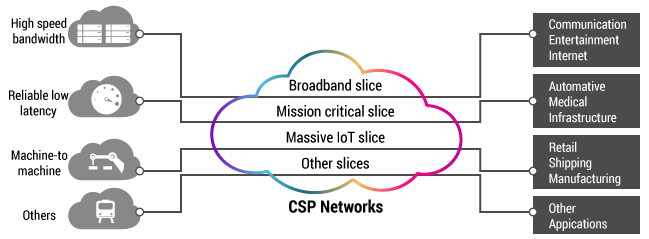Network Slicing – It’s Not Just About 5G
While the term “network slicing” typically brings up an association with 5G technology and services, they are not directly related. Network slicing simply is the ability for to carve out multiple virtual networks, with significantly different performance characteristics, from a common physical infrastructure.
5G resonates with network slicing because 5G ‘by definition’ includes distinct service classes for very high bandwidth, ultra-low latency with high availability, and massive IoT. It is hard to see how the 5G services vision is achievable without network slicing.
Yet all communication service providers (CSPs) are already in a competitive environment with different sets of customers with different service performance needs and associated expectations of SLA guarantees. Network slicing makes it much easier to accommodate this range of customers, services, and SLA assurances, than implementing overlay networks or specially engineered solutions. It maximizes the value of a single network infrastructure with an increasingly heterogeneous customer and services environment.
Network slicing can deliver multiple benefits to CSPs, even without 5G.
- New service offerings with guaranteed performance. Network slicing not only provides customers with virtual networks with specific performance characteristics, such as for bandwidth, latency, and availability – but also adds the ability to guarantee performance for these performance characteristics. Network slicing achieves this far more effectively than conventional methods by applying ‘hard’ slices.
- Customer management with operational isolation. Since network slices are programmable and have the ability to expose their capabilities through APIs, they enable extending to customers the added benefit of managing their virtual networks by themselves. This can range from passive monitoring, to actively adding and administering end-points. Moreover, network slicing delivers full operational isolation so that customers cannot inadvertently interfere with each other.
- Network resource efficiency. Since network slices use existing network resources, they do not generally require performing capacity upgrades. The impact on overall network performance should be minor whether network slices are in use or not.
In addition, here are some practical use cases that could benefit from network slicing:
- Real-time collaboration. Business locations, or even individuals, remote from each other can collaborate on projects that require stringent low latency and low jitter, where previously this would be performed at a single location by necessity. Examples revolve around instances or combinations of virtual reality, gaming, distributed performance, autonomous vehicles, and robotic control for industrial, entertainment, or telemedicine applications. (Some of these like telemedicine could have added guaranteed availability requirements.) By including 4G/LTE and future 5G resources, these projects can extend to human or machine end-points that are untethered from a physical facility.
- Bandwidth on demand. Business locations can exchange information with each other or with a data center with a guaranteed minimum bandwidth, for a particular time window. Examples are transferring data from data intensive applications (e.g. scientific research, real-time hi-def videos) to locations who will use or analyze the data, or backing up a data center in a specific maintenance window.
- Federated computing. Autonomous distributed computing resources can share information with each other with confidence that they are part of the same federation. Network slicing’s role in this use case is primarily authenticating end-points on the federated network, rather than guaranteeing particular performance characteristics.
- Wholesale services. The operator makes parts of its network available to another service provider, over which they can run their own services. The CSP profits from reselling underutilized resources. Examples can extend from packet services bandwidth, to alien wavelengths, to shared spectrum. The wholesaler customer has complete visibility of their network slice, with an ability to prioritize services they offer to their end-customers.
We can implement these use cases by creating virtual networks for each one using network slicing, where a network slice is a chain of ‘hard’ and ‘soft’ slicing resources at the transport, compute, control, and orchestration planes at a given time. As service needs or traffic conditions change, automated orchestration software shifts the hard and soft resources assigned to the network slices dynamically.
Hard slicing resources are isolated from each other in a hard manner. No matter how much their assigned users use them (and they may have fixed capacity limits) there is no impact on other users. Examples are router ports, FlexE channels, OTN channels, wavelengths, and bands of spectrum. They could also include dedicated physical compute or storage devices.
Hard slicing is particularly important for creating a performance envelope for the overall slice. They are needed to guarantee stringent latency or bandwidth performance, which is very hard to achieve using soft slicing only without massive overprovisioning or hand-crafted engineering.
Soft slicing resources have an inherent quality of being shared at some level. They include traffic-engineering constructs like segment routing, dedicated queues, and virtualized routing processing for different classes of service, or virtualized computing and storage. Prioritization for soft slicing resources typically is determined algorithmically in the event of overload by too much demand.
So why wait for 5G? It is time to start thinking about implementing network slicing today.





